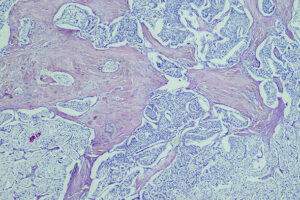Oncology
Gastroenteropancreatic Neuroendocrine Tumors
Surveillance After Complete Resection of Gastroenteropancreatic Neuroendocrine Tumors
After complete resection of gastroenteropancreatic neuroendocrine tumors (GEP-NETs), surveillance for tumor recurrence is important. Guidelines for appropriate surveillance exist for several types of NETs; however, providers do not always follow guidelines for surveillance and may order unnecessary tests for their patients. At the 2024 ASCO Gastrointestinal Cancers Symposium, researchers presented data from a cancer center in Canada on its clinicians’ adherence to national guidelines.
Following this presentation, featured expert Timothy J. Hobday, MD, was interviewed by Conference Reporter Editor-in-Chief Tom Iarocci, MD. Dr Hobday’s clinical perspectives on these findings are presented here.
I think that the goal of surveillance should be to accurately detect recurrence in a way that allows for the improvement of future patient outcomes. The time to recurrence can be prolonged 5 or 10 years, or even longer, so any surveillance strategy that I pursue usually extends out to 10 years in people who are relatively healthy and whose life spans would be expected to be that long or longer.
I monitor very few patients with biomarkers, hormone markers, serum tests, or other blood tests, as I think that doing so can be problematic because there can be false positives and false negatives. A test result may suggest tumor recurrence before we can even detect it, which is of debatable significance. Thinking that their cancer may ultimately recur but that we cannot find it yet certainly does not help the patient feel any better. So, I think that most consensus groups do not make a strong recommendation for blood tests, urine markers, or hormonal monitoring as a standard approach.
Further, we do not want to overimage patients and expose them to too much radiation or unnecessary costs. Imaging also carries the risk of indeterminate or false-positive findings that then require further testing or biopsies; this can really shake a patient’s confidence in their health to their core, even if nothing is ultimately found. After a complete resection, I generally get a good cross-sectional imaging scan, whether that is a magnetic resonance imaging (MRI) or a computed tomography (CT) scan, at some point in the first 6 to 12 months. It is important that CT scans for NETs be done with both arterial and venous phase contrast imaging, otherwise they are very insensitive to picking up liver metastases. NETs are very vascular and are detected far better with early arterial phase contrast imaging. I generally image patients once a year for the first 5 years or so, and then roughly every other year out to 10 years. I think that all the guidelines are somewhere in that range.
What we are actually achieving for the patient with routine surveillance by any of these consensus panels or these recipes for surveillance remains unknown, and that is really the struggle. Are we really discovering important information at an important time for the benefit of our patients? None of these tests tells us if we are detecting recurrence in our patients at a time when doing so will help them live longer or live better than if we detected that same recurrence, which is usually asymptomatic and small, later on. Also, when we detect small amounts of asymptomatic disease, we rarely have treatments of curative potential, and we often might just observe those patients without therapy; however, now we are doing so with the patients’ knowledge that they have recurrent cancer. I think that this is the push and pull of surveillance.
At the 2024 ASCO Gastrointestinal Cancers Symposium, researchers presented a retrospective cohort study of patients who were seen at a center in Canada for surveillance after complete resection of GEP-NETs (abstract 591). In this study, they were able to assess adherence to the Commonwealth Neuroendocrine Tumour Research Collaboration (CommNETs) consensus surveillance guidelines. The investigators reported that adherence to the CommNETs guidelines was only 23%. They also reported a lot of overordering of tests and procedures, with routine CTs being the most frequent form of oversurveillance. I think that most guidelines do not recommend getting routine chest CTs, and this is certainly the case in my practice. I would say that this study documents that too many chest CTs are being done.
Some of the nonadherence to the CommNETs guidelines was documented when ordering MRIs; however, I think that MRIs are actually very reasonable in some patients (eg, in patients for whom a CT with contrast may be a little questionable because of renal function, or in patients who do not want the radiation exposure). So, I do not know if I would call MRIs a deviation from good follow-up.
I do agree with the CommNETs guidelines that nuclear medicine positron emission tomography scans are generally a poor follow-up tool and are therefore not generally recommended in routine surveillance. The guidelines also classify ordering chromogranin A, urine 5-hydroxyindoleacetic acid, and a lot of other hormonal testing as nonadherence, suggesting that these are not necessary or useful parts of surveillance. And yet, they are commonly being done anyway. In my opinion, many physicians check too many tumor markers or hormone levels without any good evidence that the findings would be helpful. I usually do not do that in surveillance.
I thought that guidelines might be more likely to be followed in the Canadian health care system than, perhaps, in the US health care system. Nevertheless, researchers documented a lot of overordering of tests and procedures that are not recommended, and this was interesting.
Chan H, Zhang L, Choti MA, et al. Recurrence patterns after surgical resection of gastroenteropancreatic neuroendocrine tumors: analysis from the National Comprehensive Cancer Network oncology outcomes database. Pancreas. 2021;50(4):506-512. doi:10.1097/MPA.0000000000001791
Halfdanarson TR, Strosberg JR, Tang L, et al. The North American Neuroendocrine Tumor Society consensus guidelines for surveillance and medical management of pancreatic neuroendocrine tumors. Pancreas. 2020;49(7):863-881. doi:10.1097/MPA.0000000000001597
Moffat GT, Mesci A, Chadi SA, et al. Quality of surveillance in patients with completely resected gastroenteropancreatic neuroendocrine tumors [abstract 591]. Abstract presented at: 2024 American Society of Clinical Oncology Gastrointestinal Cancers Symposium; January 18-20, 2024; San Francisco, CA.
Singh S, Moody L, Chan DL, et al; Commonwealth Neuroendocrine Tumour Collaboration (CommNETS) Follow-up Working Group. Follow-up recommendations for completely resected gastroenteropancreatic neuroendocrine tumors. JAMA Oncol. 2018;4(11):1597-1604. doi:10.1001/jamaoncol.2018.2428
Strosberg JR, Halfdanarson TR, Bellizzi AM, et al. The North American Neuroendocrine Tumor Society consensus guidelines for surveillance and medical management of midgut neuroendocrine tumors. Pancreas. 2017;46(6):707-714. doi:10.1097/MPA.0000000000000850
Watanabe A, Yip L, Hamilton TD, Loree JM, Stuart HC. Tumour grade and primary site predict patterns of recurrence and survival in patients with resected gastroenteropancreatic neuroendocrine tumors. Am J Surg. 2021;221(6):1141-1149. doi:10.1016/j.amjsurg.2021.03.027
This information is brought to you by Engage Health Media and is not sponsored, endorsed, or accredited by the American Society of Clinical Oncology.










